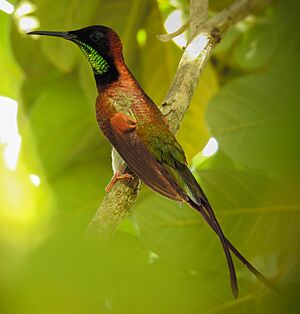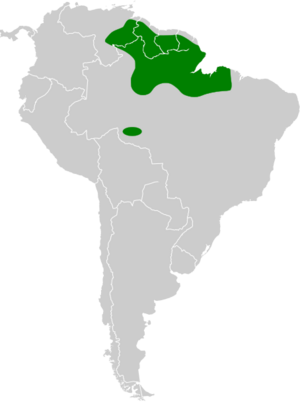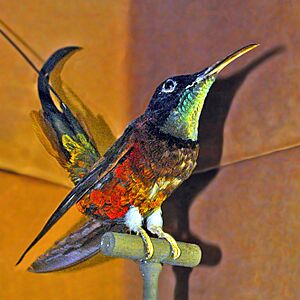Crimson topaz facts for kids
Quick facts for kids Crimson topaz |
|
|---|---|
 |
|
| Conservation status | |
| Scientific classification | |
 |
|
| Distribution of Topaza pella | |
| Synonyms | |
|
Trochilus pella Linnaeus, 1758 |
The crimson topaz (Topaza pella) is a beautiful hummingbird found in parts of South America. These include Brazil, French Guiana, Guyana, Suriname, and Venezuela. It belongs to the bird family called Trochilidae, which is the hummingbird family.
Contents
About the Crimson Topaz
Naming and Types
The crimson topaz was first officially described by a Swedish scientist named Carl Linnaeus in 1758. He gave it the scientific name Trochilus pella. Later, it was placed in the group, or genus, called Topaza. The word pella comes from Latin and means "dark-colored."
The crimson topaz is very closely related to another hummingbird called the fiery topaz. Scientists consider them a "superspecies," meaning they are very similar but still different enough to be their own species.
There are three main types, or subspecies, of the crimson topaz:
- T. p. pella (described by Linnaeus in 1758)
- T. p. smaragdulus (described by Bosc in 1792)
- T. p. microrhyncha (described by Butler in 1926)
What Does It Look Like?
The crimson topaz is a large hummingbird. It might be the second largest hummingbird species in the world! Only the giant hummingbird is definitely bigger. Its cousin, the fiery topaz, is also very similar in size.
Male and female crimson topazes look quite different.
- Males are about 21 to 23 cm (8.3 to 9.1 in) long. This includes their long bill, which is about 5 cm (2.0 in), and their tail, which can be 8.6 to 12 cm (3.4 to 4.7 in) long. They weigh between 11 to 18 g (0.39 to 0.63 oz).
* Males have a velvety black head and face. * Their back is a shiny crimson color that can look golden. * Their central tail feathers are a bronzy green, and the outer ones are chestnut brown. Two of these outer tail feathers are very long and cross over each other. * Their throat is a bright golden green, surrounded by a black band. * Their belly is bright red, and their wings are brown.
- Females are smaller, about 13 to 14 cm (5.1 to 5.5 in) long, and weigh 9 to 12.5 g (0.32 to 0.44 oz).
* Their head and back are dark green. * Their belly is a lighter green with some golden green spots. * Their throat is green with some crimson spots. * Their tail feathers are bronzy, violet, and chestnut, but they are not long and crossed like the male's.
Both males and females have a bill that is mostly straight, but it might curve down a little bit.
Where Does It Live?
The different types of crimson topaz live in various parts of South America:
- T. p. pella is found in eastern Venezuela, through Guyana and Suriname, and into northern and western Brazil.
- T. p. smaragdulus lives in French Guiana and northeastern Brazil.
- T. p. microrhyncha is found in Brazil's northeastern Pará state and on Marajó Island.
These hummingbirds mostly live in rainforests. They prefer low-lying areas and hills up to about 500 m (1,600 ft) high. They can often be seen near rocky areas or in forests that grow along small rivers.
How It Behaves
Moving Around
During the time they are raising their young, crimson topazes usually stay in one area. However, at other times of the year, they might fly to different places to find flowering plants to feed from.
What It Eats
Male crimson topazes protect their feeding spots from other birds. They mostly eat nectar from flowering trees, especially those high up in the forest canopy (the top layer of trees). They also drink nectar from flowering vines and plants that grow on other plants, called epiphytes. Sometimes, they are seen feeding from shrubs closer to the ground.
Besides nectar, they also catch small insects while flying. They hunt insects both high above the trees and low along streams.
Raising Young
The breeding season for the crimson topaz changes depending on where they live. In some areas, like the Guianas, they have two breeding seasons a year.
During courtship, male topazes perform special flights to show off their white leg feathers. The female builds a cup-shaped nest using soft fibers from Ceiba seeds and spider webs. She often places her nest on vertical branches or in vines, usually over water. A female typically lays two eggs.
Its Song
The crimson topaz's song is a "chattering" sound. It makes an irregular series of "chip" notes almost all day long, only stopping to feed. It often sings from a high perch in the treetops. Sometimes, it will fly a short distance and then return to the same perch between songs.
Status of the Crimson Topaz
The IUCN (International Union for Conservation of Nature) has listed the crimson topaz as a species of "Least Concern." This means that, for now, it is not considered to be in danger of disappearing.
However, scientists don't know exactly how many crimson topazes there are. They believe the number might be going down. It can be hard to count them because they often stay high in the treetops. Even though they are sometimes considered rare, they are also found in many protected areas. New populations are still being discovered in places where they weren't known to be before.
See also
 In Spanish: Topacio candela para niños
In Spanish: Topacio candela para niños



